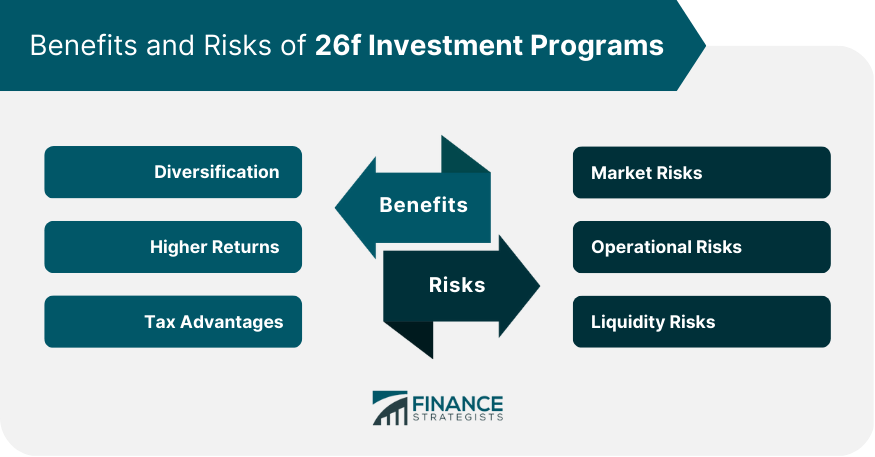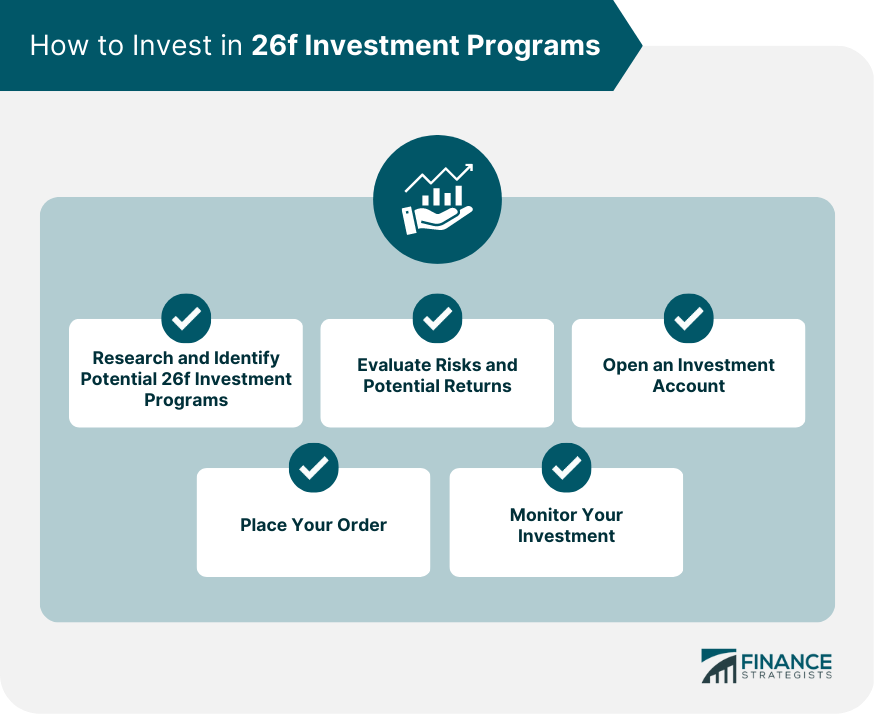26f investment programs are a type of tax-exempt investment vehicle that allows investors to benefit from tax-advantaged investing. Section 26(f) of the Investment Company Act of 1940 allows certain types of investment companies to operate tax-free, provided they meet certain criteria. These investment programs typically invest in securities such as stocks, bonds, and real estate. They can offer a range of benefits to investors, including tax savings, diversification, and the potential for higher returns. The primary purpose of 26f investment programs is to provide investors with a way to invest in securities through a tax-advantaged investment vehicle. By investing in a tax-exempt investment program, investors can potentially save money on taxes and maximize their investment returns. 26f investment programs also allow investors to diversify their portfolios by investing in a variety of securities, which can help mitigate risk and improve overall portfolio performance. 26f investment programs typically operate as investment companies, which pool money from multiple investors to purchase securities. These investment companies are typically structured as either mutual funds or exchange-traded funds (ETFs). Mutual funds are professionally managed investment portfolios that pool money from multiple investors to purchase a diversified mix of securities. ETFs, on the other hand, are passively managed investment vehicles that track the performance of a specific index or sector. Investors in 26f investment programs typically buy shares in the investment company, which represent their ownership stake in the underlying securities. These shares are bought and sold on the open market, typically through a brokerage account. The value of the shares is determined by the performance of the underlying securities held by the investment company. Investors can typically sell their shares at any time, subject to market conditions and any restrictions imposed by the investment company. Investing in 26f investment programs can offer a range of benefits to investors: These programs typically invest in a variety of securities, including stocks, bonds, and real estate. By investing in a diversified mix of securities, investors can potentially reduce their overall risk and improve their chances of achieving their investment goals. Additionally, 26f investment programs can offer the potential for higher returns compared to traditional taxable investment accounts, since they are structured to maximize tax efficiency. By investing in a tax-exempt investment vehicle, investors can potentially save money on taxes and maximize their investment returns. The tax benefits of investing in 26f investment programs can be significant, especially for high-net-worth individuals who are subject to higher tax rates. 26f investment programs may be particularly attractive to investors who are looking for ways to minimize their tax liability while still achieving their investment goals. As with any investment, there are risks associated with investing in 26f investment programs. Market risks are one of the most significant risks associated with investing in 26f investment programs. The value of the underlying securities can fluctuate based on a variety of factors, including economic conditions, industry trends, and company-specific events. This can lead to short-term volatility in the value of the investment program's shares, which could cause investors to lose money if they sell their shares during a market downturn. While market risks can be significant, they can also be mitigated through diversification, which can help to spread risk across a variety of different securities. Investors in 26f investment programs may also be subject to operational risks, such as the risk of fraud or mismanagement by the investment company. This could include issues such as accounting irregularities, conflicts of interest, or other unethical practices. To mitigate these risks, investors should carefully evaluate the investment company's management team, performance history, and reputation before investing. They should also be aware of any red flags, such as a history of regulatory violations or lawsuits, which could indicate potential problems with the investment company. Another risk associated with investing in 26f investment programs is liquidity risk. This refers to the risk that investors may not be able to sell their shares in the program when they need to. Investors can typically sell their shares on the open market. However, the liquidity of these shares can vary based on market conditions and investor demand. In some cases, investors may need to wait for several days or even weeks to sell their shares, which could be problematic if they need to access their money quickly. Investors should carefully consider their liquidity needs before investing in 26f investment programs and be prepared to potentially face delays in selling their shares if market conditions are unfavorable. Here are some examples of 26f investment programs that investors may consider: Real Estate Investment Trusts (REITs) are investment programs that invest in a portfolio of income-generating real estate properties. These properties can include a range of different types, such as apartment buildings, office complexes, and shopping centers. These are typically structured as pass-through entities, which means that they are not subject to corporate income tax. Instead, the income generated by the REIT is passed through to investors in the form of dividends. Also, REITs can offer a range of benefits to investors, including exposure to real estate investments, the potential for long-term capital appreciation, and regular income in the form of dividends. These securities can include stocks, bonds, and other types of investments related to energy exploration, production, and distribution. Energy-focused investment programs can offer a range of benefits to investors, including exposure to the potential growth of the energy sector, the potential for higher returns, and diversification across a range of energy-related investments. In addition to REITs and energy-focused investment programs, there are many other types of 26f investment programs available to investors. These can include investment programs focused on specific industries or sectors, such as healthcare or technology, as well as more diversified investment programs that invest across a range of different securities. Here are the general steps for investing in 26f investment programs: Look for 26f investment programs that match your investment goals, risk tolerance, and financial situation. You can use online resources, financial publications, and recommendations from financial advisors to find potential investment options. Consider the risks associated with investing in the specific 26f investment program you are interested in, including market risks, operational risks, and liquidity risks. Also, evaluate the potential returns you can expect from investing in the program. If you do not already have an investment account, you will need to open one with a broker or financial institution that offers access to the 26f investment program you are interested in. Once you have decided to invest in a 26f investment program, place your order through your broker or financial institution. You will need to provide information about the investment program and the amount you wish to invest. After investing in a 26f investment program, monitor your investment regularly to ensure that it is performing as expected. Stay up to date with the investment company's financial statements, news, and other relevant information to make informed decisions about your investment. 26f investment programs are investment vehicles that allow investors to take advantage of tax-advantaged investing by investing in securities such as mutual funds, exchange-traded funds that are exempt from federal income tax. They offer potential benefits such as diversification, higher returns, and tax savings, but also come with risks such as market risks, operational risks, and liquidity risks that investors should be aware of. When considering examples of 26f investment programs, investors should be aware of the range of options available, including REITs, energy-focused investment programs, and other types of investment programs focused on specific industries or sectors. In order to invest in 26f investment programs, individuals should conduct research and evaluate different types of programs to determine which ones align with their investment goals and risk tolerance. Investors interested in 26f investment programs are advised to work with a qualified financial advisor and consult with an insurance broker to evaluate their risk tolerance and ensure their investment portfolio is adequately protected. Definition of 26f Investment Programs
How 26f Investment Programs Work
Benefits of Investing in 26f Investment Programs
Diversification
Higher Returns
Tax Advantages
Risks and Considerations
Market Risks
Operational Risks
Liquidity Risks

Examples of 26f Investment Programs
Real Estate Investment Trusts (REITs)
Energy-Focused Investment Programs
Other Types of 26f Investment Programs
How to Invest in 26f Investment Programs
Research and Identify Potential 26f Investment Programs
Evaluate Risks and Potential Returns
Open an Investment Account
Place Your Order
Monitor Your Investment

Bottom Line
26f Investment Programs FAQs
26f investment programs are investment vehicles that allow investors to invest in securities that are exempt from federal income tax, such as mutual funds, ETFs, and REITs.
Investing in 26f investment programs can offer a range of benefits, including tax savings through tax-advantaged investing, diversification across a range of securities, the potential for higher returns compared to traditional taxable investment accounts, and opportunity for long-term capital appreciation.
There are several risks associated with investing in 26f investment programs, including market risks associated with fluctuations in the value of underlying securities, operational risks associated with fraud or mismanagement by the investment company, and liquidity risks associated with selling shares in the program when needed.
Some examples of 26f investment programs include REITs, energy-focused investment programs, and other types of investment programs focused on specific industries or sectors.
To invest in 26f investment programs, individuals should conduct research and evaluate different types of programs, open an investment account with a reputable brokerage firm, consult with a qualified financial advisor to determine the best investment strategy, evaluate the investment company's management team and performance history, and carefully review the investment program's investment strategy and prospectus.
True Tamplin is a published author, public speaker, CEO of UpDigital, and founder of Finance Strategists.
True is a Certified Educator in Personal Finance (CEPF®), author of The Handy Financial Ratios Guide, a member of the Society for Advancing Business Editing and Writing, contributes to his financial education site, Finance Strategists, and has spoken to various financial communities such as the CFA Institute, as well as university students like his Alma mater, Biola University, where he received a bachelor of science in business and data analytics.
To learn more about True, visit his personal website or view his author profiles on Amazon, Nasdaq and Forbes.















